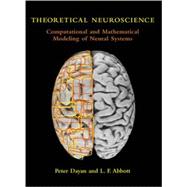
| Preface | p. xiii |
| Neural Encoding and Decoding | p. 1 |
| Neural Encoding I: Firing Rates and Spike Statistics | p. 3 |
| Introduction | p. 3 |
| Spike Trains and Firing Rates | p. 8 |
| What Makes a Neuron Fire? | p. 17 |
| Spike-Train Statistics | p. 24 |
| The Neural Code | p. 34 |
| Chapter Summary | p. 39 |
| Appendices | p. 40 |
| Annotated Bibliography | p. 43 |
| Neural Encoding II: Reverse Correlation and Visual Receptive Fields | p. 45 |
| Introduction | p. 45 |
| Estimating Firing Rates | p. 45 |
| Introduction to the Early Visual System | p. 51 |
| Reverse-Correlation Methods: Simple Cells | p. 60 |
| Static Nonlinearities: Complex Cells | p. 74 |
| Receptive Fields in the Retina and LGN | p. 77 |
| Constructing V1 Receptive Fields | p. 79 |
| Chapter Summary | p. 81 |
| Appendices | p. 81 |
| Annotated Bibliography | p. 84 |
| Neural Decoding | p. 87 |
| Encoding and Decoding | p. 87 |
| Discrimination | p. 89 |
| Population Decoding | p. 97 |
| Spike-Train Decoding | p. 113 |
| Chapter Summary | p. 118 |
| Appendices | p. 119 |
| Annotated Bibliography | p. 122 |
| Information Theory | p. 123 |
| Entropy and Mutual Information | p. 123 |
| Information and Entropy Maximization | p. 130 |
| Entropy and Information for Spike Trains | p. 145 |
| Chapter Summary | p. 149 |
| Appendix | p. 150 |
| Annotated Bibliography | p. 150 |
| Neurons and Neural Circuits | p. 151 |
| Model Neurons I: Neuroelectronics | p. 153 |
| Introduction | p. 153 |
| Electrical Properties of Neurons | p. 153 |
| Single-Compartment Models | p. 161 |
| Integrate-and-Fire Models | p. 162 |
| Voltage-Dependent Conductances | p. 166 |
| The Hodgkin-Huxley Model | p. 173 |
| Modeling Channels | p. 175 |
| Synaptic Conductances | p. 178 |
| Synapses on Integrate-and-Fire Neurons | p. 188 |
| Chapter Summary | p. 191 |
| Appendices | p. 191 |
| Annotated Bibliography | p. 193 |
| Model Neurons II: Conductances and Morphology | p. 195 |
| Levels of Neuron Modeling | p. 195 |
| Conductance-Based Models | p. 195 |
| The Cable Equation | p. 203 |
| Multi-compartment Models | p. 217 |
| Chapter Summary | p. 224 |
| Appendices | p. 224 |
| Annotated Bibliography | p. 228 |
| Network Models | p. 229 |
| Introduction | p. 229 |
| Firing-Rate Models | p. 231 |
| Feedforward Networks | p. 241 |
| Recurrent Networks | p. 244 |
| Excitatory-Inhibitory Networks | p. 265 |
| Stochastic Networks | p. 273 |
| Chapter Summary | p. 276 |
| Appendix | p. 276 |
| Annotated Bibliography | p. 277 |
| Adaptation and Learning | p. 279 |
| Plasticity and Learning | p. 281 |
| Introduction | p. 281 |
| Synaptic Plasticity Rules | p. 284 |
| Unsupervised Learning | p. 293 |
| Supervised Learning | p. 313 |
| Chapter Summary | p. 326 |
| Appendix | p. 327 |
| Annotated Bibliography | p. 328 |
| Classical Conditioning and Reinforcement Learning | p. 331 |
| Introduction | p. 331 |
| Classical Conditioning | p. 332 |
| Static Action Choice | p. 340 |
| Sequential Action Choice | p. 346 |
| Chapter Summary | p. 354 |
| Appendix | p. 355 |
| Annotated Bibliography | p. 357 |
| Representational Learning | p. 359 |
| Introduction | p. 359 |
| Density Estimation | p. 368 |
| Causal Models for Density Estimation | p. 373 |
| Discussion | p. 389 |
| Chapter Summary | p. 394 |
| Appendix | p. 395 |
| Annotated Bibliography | p. 396 |
| Mathematical Appendix | p. 399 |
| Linear Algebra | p. 399 |
| Finding Extrema and Lagrange Multipliers | p. 408 |
| Differential Equations | p. 410 |
| Electrical Circuits | p. 413 |
| Probability Theory | p. 415 |
| Annotated Bibliography | p. 418 |
| References | p. 419 |
| Table of Contents provided by Ingram. All Rights Reserved. |
The New copy of this book will include any supplemental materials advertised. Please check the title of the book to determine if it should include any access cards, study guides, lab manuals, CDs, etc.
The Used, Rental and eBook copies of this book are not guaranteed to include any supplemental materials. Typically, only the book itself is included. This is true even if the title states it includes any access cards, study guides, lab manuals, CDs, etc.